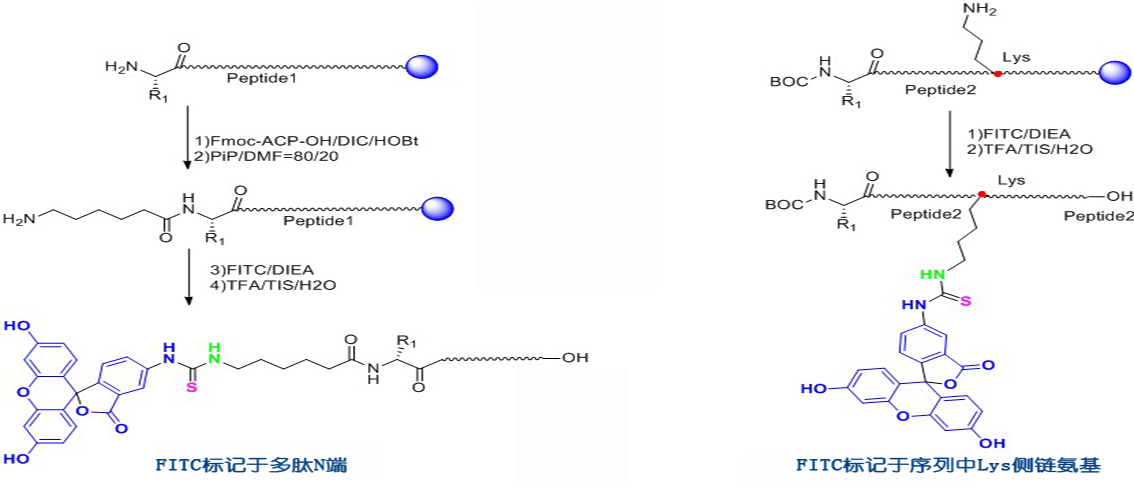Service hotline:+86-(0)-18115476705
FITC/FAM Labeling
Fluorescent dyes are the primary means of labeling biomolecules. The most common such dyes are FITC derivatives, which have a wide range of applications in fluorescence microscopy, flow cytometry, and immunofluorescence-based assays. TGpeptide provides many kinds of fluorescent labelings: FITC, FAM, TAMRA, MCA etc. Contact us if your fluorescent dye is not on the list.
TGpeptide provides fluorescent labelings including FITC, FAM, TAMRA, MCA etc.
Here are structures for part of them:

Here we list Ex(nm) and Em(nm) for Fluorescent dyes in following table:
Hydroxycoumarins
325
386
>R-phycoerythrin
(PE) (489)
565
578
Dansyl chloride
340
578
Rhodamine Red-X
560
580
AMC
345
445
Tamara
565
578
7-Methoxycoumarin
360
410
Alexa fluor 555
556
573
Alexa fluor
345
442
Alexa fluor 546
556
573
3-Aminocoumarin
350
445
Rox
575
602
Dabcyl
453
-
Alexa fluor 568
578
603
Cy2
490
510
Texas Red
589
615
FAM
495
517
Alexa fluor 594
590
617
Alexa fluor 488
494
517
Alexa fluor
621
639
FITC
495
519
Alexa fluor 633
650
668
Alexa fluor 430
430
545
Cy5 (625)
650
670
5-FAM
492
518
Alexa fluor 660
663
690
Alexa fluor 532
530
555
Cy5.5
675
694
HEX
535
556
TruRed 490
675
695
5-TAMRA
542
568
Alexa fluor 680
679
702
Cy3
550
570
Cy7
743
767
TRITC
547
572
Cy3.5
581
596
FITC is more reactive than carboxy fluorescein, which must also be activated before use. After the selective unmasking of a protecting group, FITC might react with either lysine, an ornithine side chain, or with a primary amino group at the N-terminus of the growing peptide. In this latter case, an alkyl spacer such as aminohexanoic acid (Ahx) is introduced between the last amino acid and the thiourea linkage that is generated during the reaction between isothiocyanate and amine. FITC can react extensively with sulfhydryl groups, such as the side chains of reduced cysteine residues too.

AMC(7-Amino-4-methylcoumarin) is another widely used fluorescein, but AMC is different because it is labeled at C-terminal of peptide:
(1)AMC reacts with alfa- carboxy of first amino acids at C-terminal(AA-AMC);
(2)Synthesize the left peptides sequence (from the second amino acid from C-terminal of the peptide) using SPPS;
(3)Couple AA-AMC what we get in step (1) to full-protected peptides what we get in step (2) using liquid phase reaction;
(4)Make cleavage for peptide what we get in step(3), then we get AMC labeled peptide.

Basically, Fluorescent dyes such as biotin and FITC can generally be added to either the N- or C-terminus of a peptide. But we recommend adding such modifications to the N terminus of peptides because it results in shorter turnaround time, is more likely to be successful, and does not require additional coupling steps. The addition of an N-terminal modification is the final step in the SPPS protocol because peptides are synthesized from the C- to the N-terminus. We also recommended that clients include a flexible spacer, such as the six-carbon linker Ahx, in their synthetic peptide projects because it increased the stability of the fluorescent label. FITC can also be linked readily to the thiol of cysteine or an amino group of lysine.
Copyright © Nanjing TGpeptide Biotechnology Co.,Ltd.